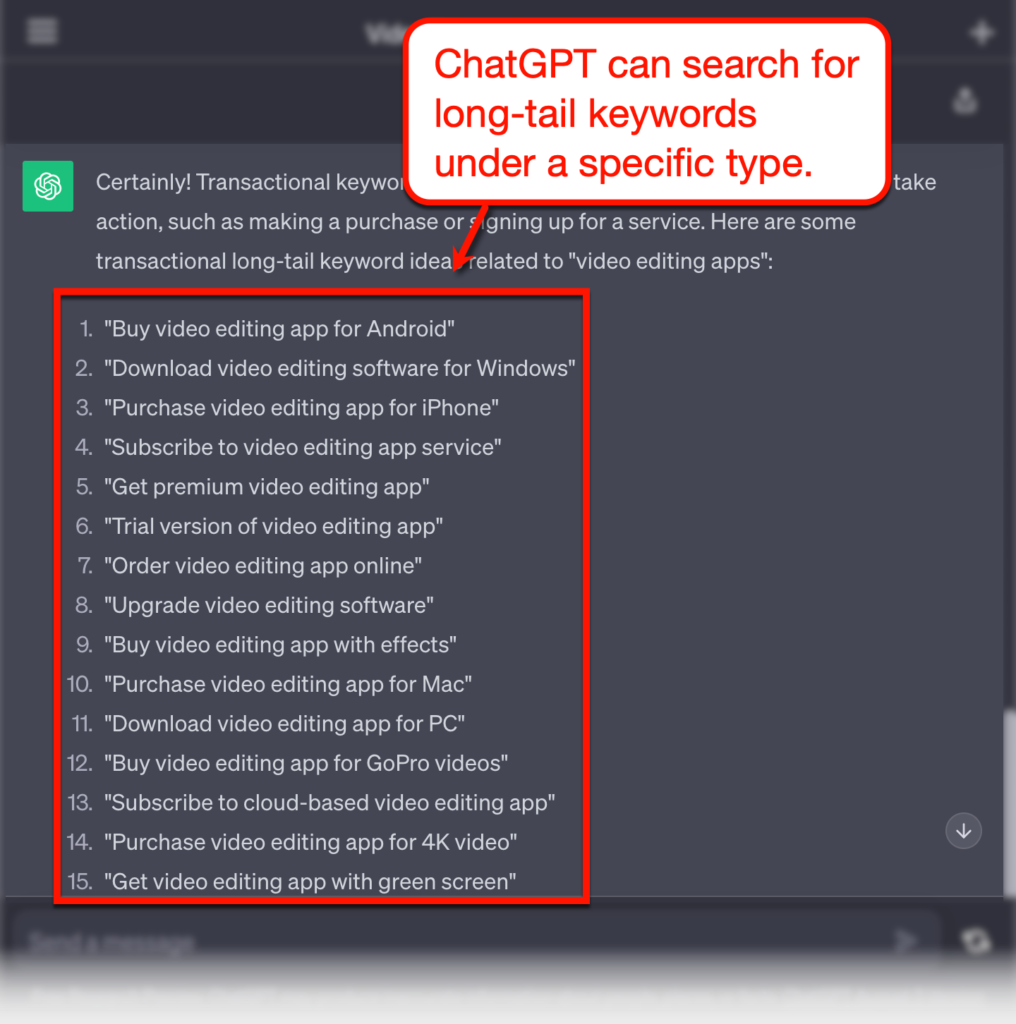You’ve come to the correct place if you want to discover long-tail keyword research techniques.
Long-tail keywords allow you to target readers with particular search intent and are also less competitive than broad keywords.
These are 15 tried-and-true methods (that I personally use) for locating valuable long-tail keywords.
Best Tools to Find Long-Tail Keywords for SEO

1. ChatGPT
Even if I’m not a supporter of knowledge that is solely produced by AI, I can see how useful AI technologies may be when it comes to helping with boring content marketing jobs.
For instance, ChatGPT is a useful AI chatbot that can generate any kind of content, including blog entries, long-tail keyword ideas, and JavaScript code.

To do long-tail keyword research using ChatGPT, register and launch a new chat.
Just ask ChatGPT to provide a list of long-tail keyword variations based on a seed term from there.
Simply provide them a request, such as “Please suggest long-tail keywords for the seed keyword, “video editing apps.””

In a matter of seconds, ChatGPT will fulfill your request.

As an advice, you might ask ChatGPT to provide you with a particular long-tail keyword type.
Say your goal is to draw in readers who are highly motivated to make a purchase. For the seed keyword “video editing apps,” just change your query to something like this: “Give me transactional long-tail keyword ideas.”
ChatGPT will respond to your request right away.

You can also ask ChatGPT for advice on how to use long-tail keywords in your content as an extra bonus.
Use a simple question such as “Give 10 long-tail keyword ideas for the seed keyword ‘video editing apps,’ and suggest how we can incorporate them into our content strategy” to accomplish this.
And ChatGPT will immediately cooperate.

Pros and Cons of ChatGPT for long-tail keyword research
Pros
- Free to use.
- Able to handle any request that doesn’t call for specialized gear or software.
- Essentially endless long-tail keyword suggestions.
- Sort long-tail keywords according to the type of search (commercial, transactional, informative, and navigational).
- Get advice on how to include keywords in your content marketing plan.
Cons
- Incapable of extracting keyword metrics such as difficulty, search volume, and CPC.
- Unable to find potential keywords by analyzing current pages.
2. Suggest Machine
A free program called Suggest Machine was created with the express purpose of generating long-tail keyword ideas for any subject.
To begin, you are not even need to register for an account. Simply open the website, select your target markets, insert up to ten seed keywords or subjects, and click “Get Long-Tail.”

Suggest Machine will display question-based keyword ideas and suitable long-tail keyword suggestions after a short while.

Note that you can also define which terms to include or remove by using filters. This will maintain the relevance and excellence of Suggest Machine’s keyword suggestions.

Combine Suggest Machine with a browser extension for keyword research, such as Ubersuggest, to maximize its potential. In the Google search results, this provides helpful keyword analytics directly.
Return to your list and use the first suggested keyword to conduct a Google search.
Using the Ubersuggest browser extension, check the keyword’s search volume and look for websites with low Domain Authority (DA) in the top five results. These suggest that you may be looking at a low-hanging fruit term that has some potential for ranking.

For as many Suggest Machine keywords as necessary, use the preceding procedures. Just keep in mind to focus on low-DA websites that rank for long-tail keywords with strong search volume.
Pros and Cons of Suggest Machine for long-tail keyword research
Pros
- 100% free to use.
- To begin, you don’t need to create an account.
- Create question-based and long-tail keyword lists.
- To narrow down your keyword search, apply filters.
- Functions well with additional SEO tools (e.g., browser extensions, tools for researching keywords).
Cons
- Requires external software in order to function.
- Excludes keyword analytics.
- Only the ability to generate keyword ideas; no further functionality.
3. Google Search Console
A free tool called Google Search Console was created to assist website owners in keeping an eye on specific SEO factors. It’s also a useful method for identifying long-tail keywords that need more optimization, particularly question-based keywords, when done correctly.
Open Google Search Console first, then select “Performance” from the main menu.

Choose “Query” by clicking “New” on the “Filters” tab. Next, click “Apply” after choosing “Custom (regex)” from the first drop-down box. Then, type “(?i)^(who|what|where|when|why|how)” without quotes.

Google Search Console is prompted by this query to display question-based keywords that drive traffic to your blog.
Naturally, you should ignore keywords for which you have already written a blog post. Instead, search for question-based keywords for which you lack material.

Once you have these keywords, think about creating new content entirely or modifying already-written material to specifically target them. In either case, make sure to look through the top 10 search results for each term to find suggestions from rivals for optimization.
Pros and Cons of Google Search Console for long-tail keyword research
Pros
- Identify low-hanging fruit terms.
- Find fresh opportunities for content optimization.
- Examine new topics that your target audience is interested in.
- Free to use.
- Tracks information on more SEO factors for your blog
Cons
- Does not monitor important keyword metrics.
- Requires an active page URL from your domain in order to function.
- Cannot be used to find seed keywords and long-tail keyword variations.
4. Keyword Magic Tool (Semrush)
Semrush is a comprehensive SEO and visibility management platform that provides all the resources you require to start, expand, and reinforce your online presence.
The significance of Semrush to my blogging strategy cannot be overstated. It aids with keyword research as well as the management of my on-page SEO and content strategy.
Go to “Keyword Magic Tool” under “Keyword Research” to use Semrush for long-tail keyword research.

Click “Search” after entering a seed term in the Magic Tool interface. To guarantee that you obtain long-tail keywords that your target audience utilizes, don’t forget to define your target nation.

By providing a comprehensive list of long-tail variations for your seed term, Magic Tool gets right to the point. Important details like search volume, keyword difficulty, search intent, and CPC are also included in the report.
Simply click on the header of any column to quickly sort the list using the metrics of your choice. For example, click the “KD” column header twice if you wish to start with finding low-competition keywords.

Click on a keyword to open the Keyword Overview report and discover more about it. The top 10 organic results and related keyword ideas are just a couple of the helpful insights you can discover here.
Pros and Cons of Semrush Keyword Magic Tool for long-tail keyword research
Pros
- A strong yet user-friendly tool for researching long-tail keywords.
- Track backlinks and keyword ranks on the same platform.
- Examine rival domains to find ideas for long-tail keywords.
- Obtain related keywords, question, phrase, broad, and exact matches.
- To extract the best keyword suggestions for your approach, create smart filters.
- All-inclusive toolkit for local SEO, social media, advertising, and content marketing.
- Site audits can provide recommendations for on-page SEO.
Cons
- It is not possible to buy Keyword Magic Tool separately.
- For small bloggers, Semrush subscriptions may be beyond their means.
5. LowFruits
Using the appropriately called LowFruits is another method for locating low-hanging fruit keywords.
As promised, LowFruits is designed to identify low-hanging fruit keywords that have significant traffic potential with minimal effort.
Open “Kwd Finder” from the main dashboard to begin using LowFruits. After entering a target country, language, and seed keyword, click “Find keywords.”

Remain calm and let LowFruits handle the work. Click “Access” to view the list of long-tail keyword suggestions for your seed keyword after the results are in.
Remember to pick the keywords that strike your interest and select “SERP Extr.” from the toolbar at the bottom. As a result, LowFruits will be prompted to gather crucial keyword metrics and spot low-hanging fruit.

The analysis contains the average word count, search characteristics, CPC, and search volume for each selected keyword. Long-tail keywords with “weaknesses”—that is, low-DA websites that have achieved high rankings—will be at the top of the list.

Pros and Cons of LowFruits for long-tail keyword research
Pros
- To locate appropriate keywords quickly based on your SEO goals, use filters.
- Choose a DA rating threshold to obtain only relevant keyword suggestions.
- Using a long list of terms, visually locate low-hanging fruit chances.
- Seek out terms that have a certain search purpose.
- Export keyword suggestions to a different SEO or keyword research tool.
- Includes additional SEO tools such as a sitemap explorer and domain analyzer.
Cons
- No free option.
- Even with a paid subscription, keyword research is credit-based and subject to expiration.
6. Quora and Reddit
Two of the best websites for finding popular blog topics are Quora and Reddit.
However, they’re also ideal for providing you with low-hanging fruit keywords that are profitable when you use a strong tool like Semrush.
The problem is that, although they may rank for hundreds of long-tail keywords through forum conversations, Quora and Reddit don’t always give users an adequate education. This is your opportunity to intervene, provide readers with a more “complete” article, and improve your Google rankings.
Navigate to “Organic Research” under “Competitive Research” to accomplish this. Click “Search” after entering “reddit.com” or “quora.com.”

Navigate to the “Top Keywords” part of the Organic Research report, select the “Organic” tab, and select “View all keywords.”
Utilizing filters to identify appropriate phrases is the next step. Simply type your seed keyword into the area labeled “Filter by keyword” and press the magnifying glass button.

After a refresh, Quora or Reddit-ranked long-tail keywords should now be included in your keyword list.
Also feel free to apply other filters, such as a keyword difficulty range, search volume, or phrases to exclude, to further refine your search.

Remember that since forum posts are simpler to outrank than full-length publications, long-tail keywords from Quora and Reddit are typically less competitive. However, it’s critical to select long-tail keywords that are relevant to subjects that your intended audience finds interesting.
Pros and Cons of Quora/Reddit for long-tail keyword research
Pros
- Free to use.
- Look for inquiries that could make for blog posts.
- Excellent source for long-tail keywords (in combination with other tools).
Cons
- To reveal keyword metrics, an additional keyword research tool is required.
- Not thought properly in terms of keyword research.
7. SE Ranking
Over the years, SE Ranking has been one of the few SEO tools that has truly captured my interest. Its feature set is comparable to that of the best platforms, but its UI is kept uncomplicated and clear.
Go to the “Keyword Research” tab to locate long-tail keywords with SE Ranking.

Type in a seed term associated with your subject. Click “Analyze” after choosing your desired nation to begin looking for long-tail keywords online.

You will be taken directly to the keyword overview report by SE Ranking. Additionally, the “Keyword Ideas” section containing possible long-tail keyword variations is located a little bit farther down.
To view the complete list, go ahead and select “View Detailed Report.”

SE Ranking incorporates search volume, keyword difficulty, and search intent in addition to long-tail keyword ideas. Use the tabs above for “Related,” “Questions,” and “Low Search Volume” to obtain even more keywords.

Adding keywords to your Keyword Manager list, which tracks metrics in real-time and allows you to export keywords into XLS or CSV files, can help you expand on your study.
Pros and Cons of SE Ranking for long-tail keyword research
Pros
- Capabilities for keyword research on par with premium solutions like as Semrush.
- Simple to use and even simpler to learn.
- Collect long-tail keyword suggestions from rivals.
- Conduct website audits to find tips for on-page SEO.
- Using analytics and auto-posting, manage your social media accounts.
- Examine backlink lists.
Cons
- The precision of keyword search volume is still being adjusted.
- It is need to purchase important add-ons for local SEO and content marketing separately.
8. Serpstat
Similar to Semrush, Serpstat is another one-stop shop for SEO. It has a ton of useful capabilities for every aspect of your campaign, like keyword idea clustering and domain analysis.
Click “Overview” under the “Keyword Research” option to find long-tail keywords. After selecting your target country and entering your seed term, click “Search.”

In the “Organic keywords” section of the keyword overview report, select “All keywords.” In addition to the already listed keywords, this will provide you with hundreds of long-tail keyword possibilities.

This will produce a lengthy list of potential long-tail keywords as well as important details like search traffic, cost per click, keyword difficulty, and SERP elements.
Visit “Related keywords,” “Search suggestions,” and “Search questions” for even more inspiration. By doing this, you can create a broad range of target keywords for your SEO campaign.

Pros and Cons of Serpstat for long-tail keyword research
Pros
- Many features for managing marketing are packed into the platform.
- Examine popular keywords in the industry you are targeting.
- Create keyword clusters in Serpstat to help you plan your content strategy.
- Take ideas for keywords from rival businesses.
- For tasks like content creation, keyword optimization, and extraction, use AI tools
Cons
- For new users, the sheer quantity of functions can be a little confusing.
- For reporting tools, a more costly “Team” subscription is required.
9. Google Trends
The sole objective of Google Trends, a free marketing tool, is to identify globally trending search terms.
To get going, all you need is a Google account. Google Trends will recommend topics relevant to search engine users as you type your seed term.

If you want to get long-tail keyword suggestions for your topic, scroll down to the “Related queries” area. To access other keywords, use the bottom navigation arrows.
Recall that these are “breakout” and popular themes that can bring in a lot of traffic to your website. While reader interest is still at its highest, write on any question you uncover that fits in with the value propositions of your blog as soon as possible.

To get helpful information, try entering your Google Trends terms into Semrush or Serpstat, two other tools. Be mindful of search intent, search volume, and keyword difficulty to make sure your campaign is targeting the appropriate terms.
Pros and Cons of Google Trends for long-tail keyword research
Pros
- Find popular keywords that are trending right now and can drive a ton of traffic.
- Free and easy to use.
- Examine interest in keywords over time.
- Divide up the regions of interest in searches.
- Finds relevant subjects as well to support your content strategy.
Cons
- Does not retrieve metrics for keywords.
- Requires an additional keyword research tool.
10. KWFinder by Mangools
Mangools’ KWFinder is a keyword research tool designed to emphasize high-demand and low-competition keyword ideas. You can use a competitor’s URL or a seed term to begin your search.
Navigate to the necessary tab on KWFinder, choose your target audience, input a seed keyword or URL, and then click “Find keywords.”

A brief compilation of long-tail keyword recommendations, including with information on their monthly search volume and keyword difficulty, will be produced by KWFinder. Use the buttons beneath the “Filter” tool to identify certain keyword kinds, whether they are autocomplete or question-based suggestions.

If you click on any keyword, further information will appear at the bottom of the page. This covers the monthly search volume for the term, a study of the keyword’s difficulty, and the top SERP results.
Pros and Cons of KWFinder for long-tail keyword research
Pros
- Includes one of the easiest-to-use user interfaces I’ve ever encountered.
- Simple and obvious technique for rating the complexity of keywords.
- Examine popular terms and monitor the rise in search volume over time.
- Get question-based and autocomplete keywords in one place.
Cons
- The entry-level plan can only search for 25 keywords.
- The keyword difficulty grade for some terms was determined months ago.
Conclusion
Long-tail keywords offer profitable chances to rank highly and draw targeted traffic to your website. As a result, you must pick your keyword research tools carefully and intelligently.
Any of the following tools works well for locating lucrative long-tail keywords, especially when combined with the actions I demonstrated. In the end, remember your SEO objectives, financial constraints, and level of experience to select the ideal instrument and approach.
